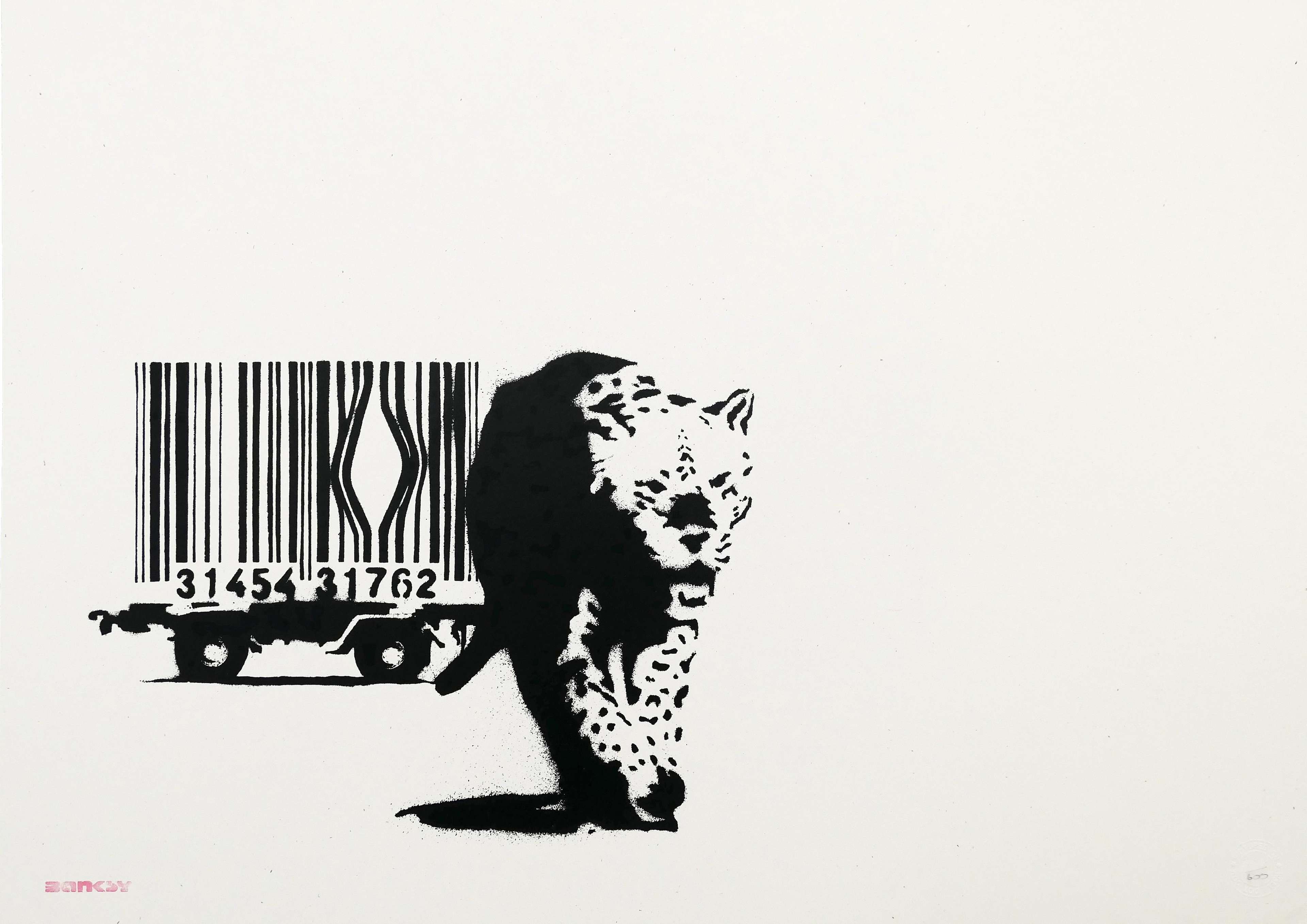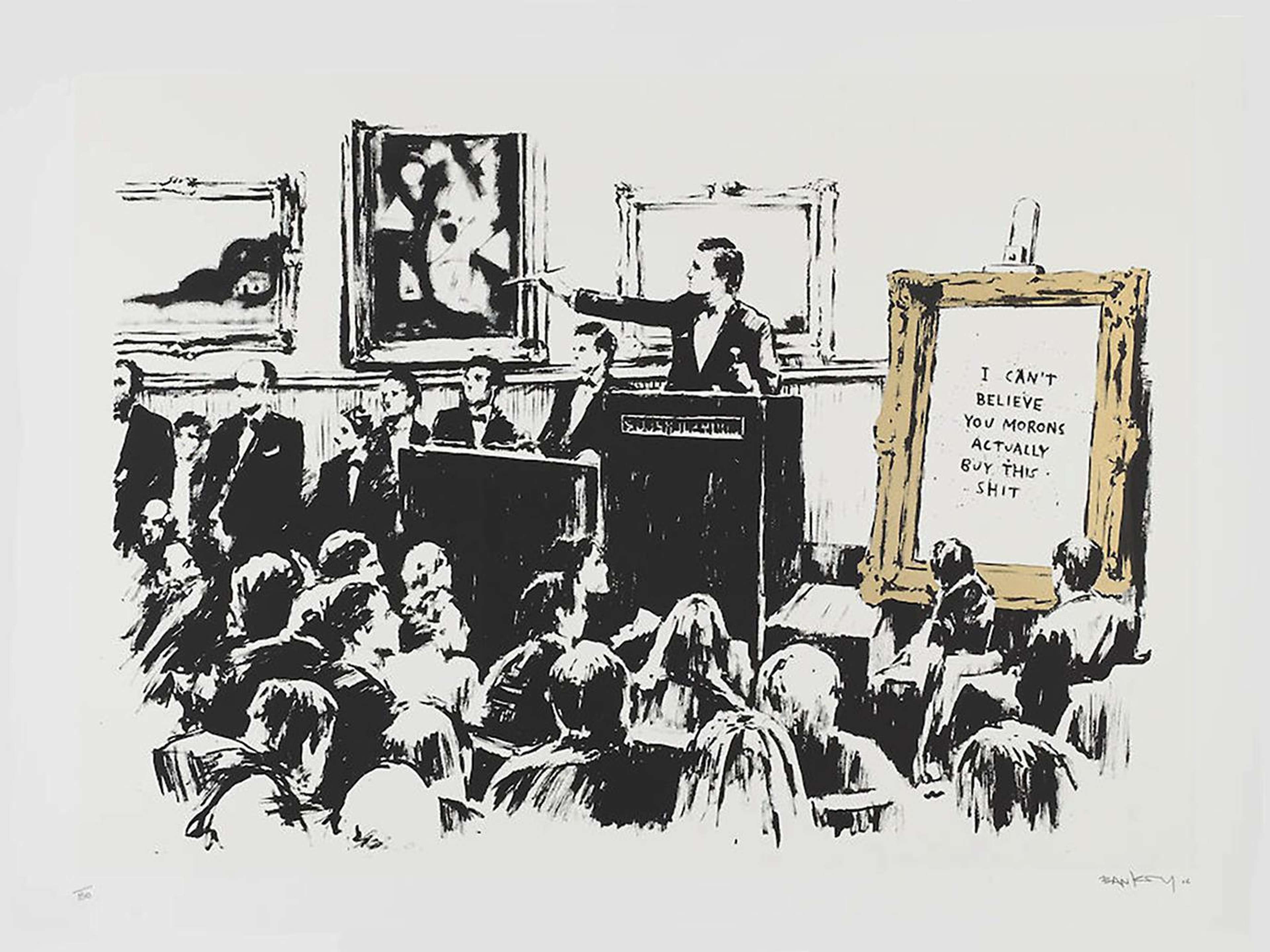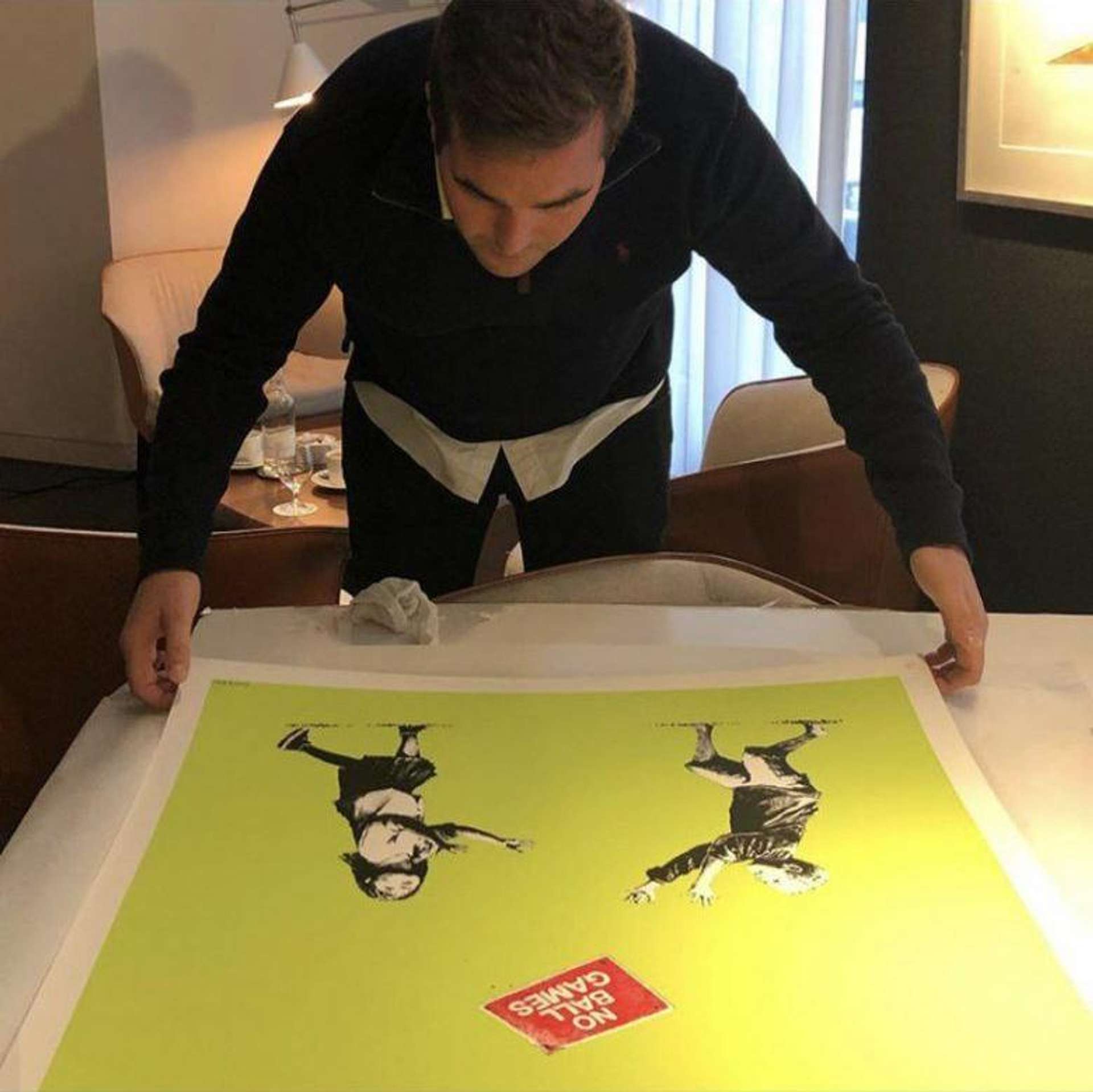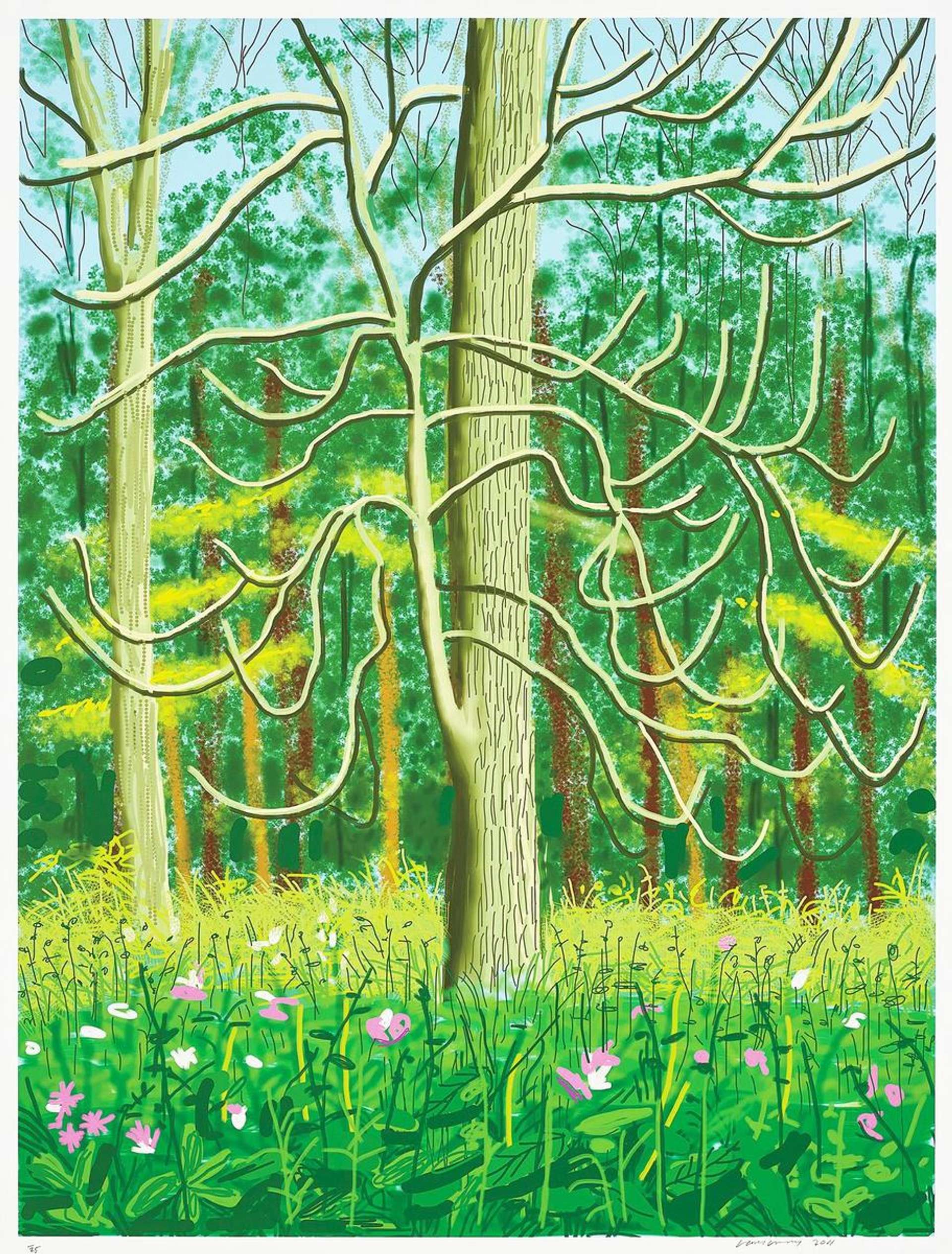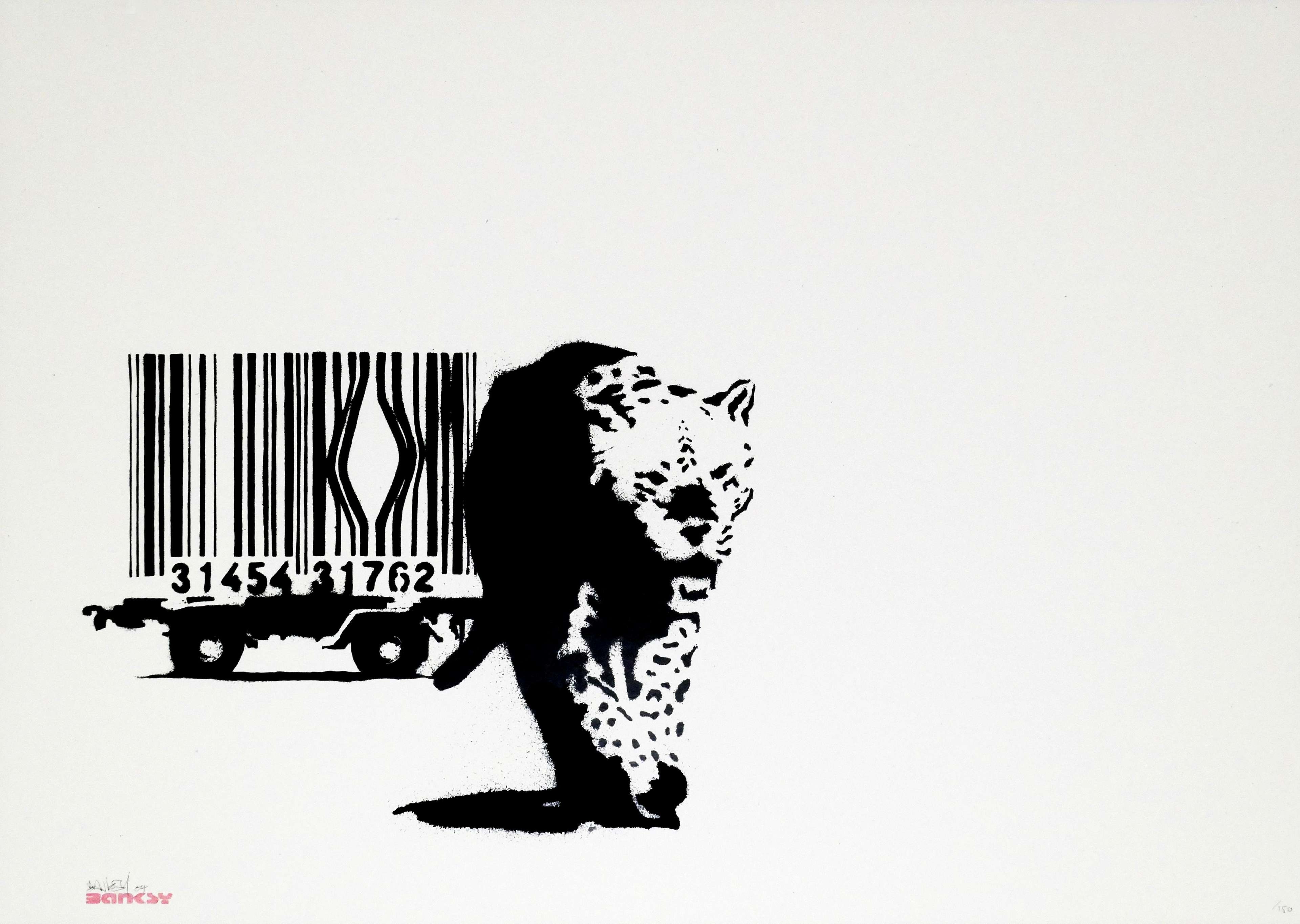 Barcode © Banksy 2004
Barcode © Banksy 2004Live TradingFloor
The ultimate glossary to technical terminology around printing and editions, including techniques, pricing and examples.
Making a print might involve the reproduction of an image, but a fine art print is much more than just a replica. It is the result of close collaboration between the skilled techniques at the printing studio and the artist’s design, usually doing so with the specific format of a limited edition series in mind. The prints are released onto the market usually strategically by the artist themself, a commercial gallery or a publisher and they represent a major aspect of artistic practice.
Artists produce editions for a variety of reasons. Famous street artists such as Banksy have a practice centred around public art that isn’t intended for commercial use but instead to be enjoyed by everyone freely. This is complimented by his extremely successful secondary market of prints and editions that ensures the artist’s stable value on the market. For legendary Pop artist Andy Warhol, screen printing was an integral part of his practice and ethos, which focused on appropriating and mass-producing familiar imagery.
Basic Terms
Prints are unique artworks in their own right, not to mention an absolutely essential segment of the global art market. They are the perfect gateway into collecting art and becoming familiar with a specific artist’s market, since they’re usually less expensive than original works but are part of a much more dynamic circulation and are valuable editions to any collection.
Print Edition
A print edition tells you the total number of impressions of a particular print. This will usually be indicated at the corner or edge of the print written in pencil along with the print number. The size of the edition is a crucial indicator of value – the smaller the edition, the rarer, more sought-after and more expensive the individual prints.
Numbered Print
The print number indicates the individual position of the print and the total number within the given edition. This can usually be found in the corner of the print, often written in pencil, in the form of a fraction. For example, ‘21/150’ means the artwork is number 21 within an edition of 150.
AP or Artist Proof
Today, Artist Proof prints are the same as other prints within the edition. However, they’re still more desirable mostly because of their tradition and their rarity. Back in the day when printmaking technology was less advanced, the first prints of an edition came out higher quality because the printing plates gradually wore out as they were reused during the overall production. These first prints were often kept by the artist for themselves, hence the term “Artist Proof”. Sometimes these would act as working trials, meaning they would show additional annotations by the artist.
With today’s advances printing technology this is no longer the case and each print is identical in quality independently of the printing technique used.
APs are still in higher demand and have a slightly higher price however, because of their limited number within an edition.
One of the highest selling pieces at Sotheby’s March 2020 Banksy Online auction was the Artist Proof edition of his famous Girl with Balloon print:
BAT or Final Proof
Final Proof prints are in high demand because there is only one in an edition. It’s the final print approved by the artist that determines what the rest of the edition will look like.
PP or Printer’s Proof
PPs are also slightly more expensive than APs because they’re fewer in number. Printer’s Proofs are prints given to the studio or the printers working with the artist on the edition often as a thank you – their number within an edition also depends on how many technicians worked on a project.APs and PPs are indicated as fractions on the bottom of the print in the same way: 1/5 AP and 1/5 PP.
Hors Commerce
Hors Commerce, a French term, means ‘out of trade’ in English. HC prints are only available from the artist directly. HCs are extremely rare and thus the most valuable.
Print Types
The printmaking tradition is very rich and constantly evolving. There are various kinds of techniques, but the best-known include etchings, screen prints, lithograph prints, digital prints and woodcuts.
Etching
To produce an etching, the artist scratches an image onto wax-covered metal plate with an etching needle. Afterwards, the scratched plate is submerged in acid that deepens the lines of that image into the metal – the longer it’s exposed to the acid, the darker and deeper the lines will be. The metal plate is then cleaned, and the lines are filled with ink. Damp paper and a cloth are put over the plate, which is then pressed through an etching press so that the paper picks up the ink from the incised lines. The resulting image gets printed in reverse.
Screen printing
Screen printing is one of the most common printing techniques and is often used by contemporary print makers such as Banksy and KAWS. It was extremely important around the time of Pop Art and the likes of Andy Warhol and Roy Lichtenstein, who popularised it in the 1960s.
Screen printing allowed them to use and copy familiar images from the mainstream, as well as to mass produce them with the help of assistants. Warhol’s prolific output of prints could not have been possible without this trailblasing technique.
The screen printing process involves the image being cut into a sheet of paper to create a stencil, which is then then put in a frame with layer of mesh stretched over it. This is the ‘screen’.
A sheet of paper is placed under the screen and the ink is squeezed through the stencil from above with a squeegee, or rubber blade. A photographic image can also be reproduced through screen printing with the use of light-sensitive gelatine.
Lithography
Lithography was first used in the 19th century but was later embraced by the Modernists, including David Hockney and Jasper Johns.
For the process of creating a lithograph, the image is first sketched onto stone with a grease-based medium such as crayons or tusche ink. A chemical solution is then applied to the stone to ensure the image will catch printing ink and the rest will attract water and repel ink. The stone’s surface is then dampened with water and coated with oil-based ink, which will only be attracted by the area with the image.
As the final step, the ink-covered stone is placed on a lithographic press with a sheet of damp paper and a board pressed evenly over it. The image is printed in reverse.
Lichtenstein’s lithographs from the much sought-after Haystack series, illustrates how using different stones for separate images can create a variety of colours.
Digital printing
Digital printing is a common and easy way to create reproduction with a computer and an ink-jet printer. The digital information of the image is fine-tuned to ensure that the resulting print completely matches the original work. The most common forms of digital prints are giclee prints. This process (literally meaning “to spray”) involves spraying ink in mists of tiny dots onto paper or canvas.
This is a term you may see a lot in the category of photography. The majority of contemporary digital photographic prints are either c-type (laser) or giclée (inkjet) but historical photographs may have been made a number of interesting techniques.
Woodcuts
Woodcuts are the oldest printmaking technique but still used today by the likes of Damien Hirst. For this process, the image is sketched and then carved onto a woodblock. The wood is then coated with ink and a sheet of paper is placed and pressed on top, leaving the impression of the carved image in reverse.
Condition and Care
Condition can be one of the most crucial factors that influence the value of a print and it’s the seller’s responsibility to ensure the work has been stored carefully and kept in pristine condition when it comes to offering a work back to the market.
Sometimes some aspects such as age can be up to subjective preference, for instance if a collector is looking for an older look of the paper with a more historic print. However, even the slightest crease or discolouration can drastically lower the price of any work of art.
For more tips on storage, condition and display of prints visit our in-depth guide to caring for a collection of prints here.
Understanding Condition Reports
Here are some of the key terms that are useful to know if when receiving a condition report on a print you’re looking to buy or sell.
Foxing – Brown spots on the paper due to moisture or age
Creasing – Wrinkled surface of paper due to inconsiderate handling or storage
Warping – Wavy, uneven surface of paper due to moisture
Holes, rips – Any tears in paper due to poor handling and storage
Discolouration – a change in colour due to aging (oxidation and acidity of paper) and thus not easily preventable. Common for antiques.
Trimming – literally trimming made around the paper’s edges, this is permanent damage and cannot be amended.
We would recommend seeking expert advice in case you need to restore any damages to your print. MyArtBroker has a network of trusted specialists and experts we can connect you to, who can tend to any damages and they can offer advice free of charge.
Print Value
There are a multitude of factors determining the value of a particular print, including most of the aspects explained above.
On the most basic level, whether a print is signed or unsigned is a fundamental indicator of value. Signed prints will be rarer and thus higher in value. Condition plays a huge part, as no collector or gallery is going to invest in a damaged print.
Exhibition and provenance history will also impact price significantly, which is why it’s incredibly important that you obtain documents pertaining to all such information upon purchasing a print. For instance, if you want to sell a Warhol print like Campbell’s Soup and you have evidence of it being previously exhibited at a museum or having been in a noted collection, its value and appeal will increase significantly.
Depending on the artist, the print type and technique will also influence the artwork’s desirability and marketability. In the case of Roy Lichtenstein, his lithographs inspired by comic strips, such as Whaam! or Shipboard Girl are among his most popular works along with his series of woodcuts mentioned above.
Andy Warhol is known as the father of screen prints, and so naturally his most notorious works such as Marilyn Monroe will fetch for a high price.
With someone like Banksy, most of his works are screen prints and all of them have a stable, extremely coveted market. With him it makes more sense to keep an eye on the size of the edition and whether it’s signed or not; Christ With Shopping Bags for instance was released in a small edition of 82 with all works signed, which makes it highly sought-after, whilst Girl with Balloon is his most widely known work and therefore draws considerable attention.
For some artists, a particular series might be most well-known and thus the most attractive investment; the Penguin series of screen prints based on the dust jackets of Penguin classics books would be an example of such for the artist Harland Miller.
If you’re looking for advice on evaluating a print or looking to buy and aren’t sure what you should pay, don’t hesitate to reach out to us at MyArtBroker for expert advice in any area of the contemporary and modern print market.

